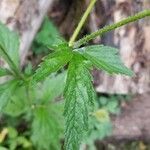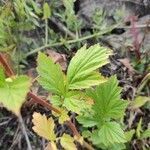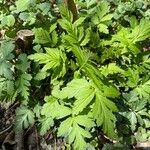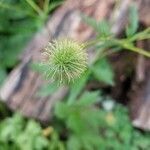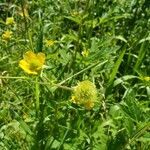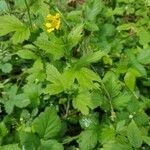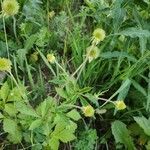Plants leafy-stemmed. Stems 30–120 cm, hirsute to sparsely hirsute. Leaves: basal 10–35 cm, blade interruptedly pinnate, major leaflets 5–9, alternating with 4–6 minor ones, terminal leaflet usually only slightly larger than major laterals; cauline 4–19 cm, stipules ± free, 8–28 × 5–22 mm, blade pinnate to 3-foliolate. Inflorescences 3–7-flowered. Pedicels puberulent, hirsute, eglandular. Flowers erect; epicalyx bractlets 2–3.5 mm; hypanthium green; sepals erect but soon reflexed, 4–8 mm; petals spreading, yellow, nearly orbiculate to broadly ovate or obovate, 5–9 mm, equal to or slightly longer than sepals, apex rounded, occasionally irregularly notched. Fruiting tori on 2–3 mm stipes, densely downy, ?hairs soft, 0.3–0.7 mm?. Fruiting styles geniculate-jointed, proximal segment persistent, 3–6 mm, apex hooked, bristles on basal 1/3, eglandular, distal segment deciduous, 1–2 mm, pilose in basal 1/2, ?hairs much longer than diam. of style?. 2n = 42.
Stems stout, to 1 m, very hirsute, especially below; lvs highly variable, but their lfls or lobes mostly obovate or oblong, distinctly cuneate at base; lower lvs on long petioles, the principal lfls often mingled with minute ones; lfls mostly incised-serrate; pet yellow, about equaling or slightly exceeding the sep; achenes numerous, ca 200 or more, divaricately hispid about the summit, otherwise glabrous or appressed-hairy; basal segment of the style often hirsute below; terminal segment conspicuously short-hirsute; receptacle glabrous or merely short-hispid; 2n=42. Swamps and wet meadows; interruptedly circumboreal. Amer. plants, the var. strictum (Aiton) Fernald, as here described, occur from Nf. and Que. to Yukon, s. to N.J., Ind., Ill., Io., and N.M. May–July.
A small herb. It grows 50 cm high and spreads 40 cm wide. The leaves are made up of several pairs of toothed leaflets. They grow on opposite sides of the stem. There is one leaflet at the end. The leaves have 5-11 segments. Each one is 10 cm long. They have fine teeth. The flower stem is upright and branching. The flowers have 5 yellow petals. They occur in groups on stalks. The flowers are yellow to orange. They are 18 mm wide. The seeds are hairy and in a tight cluster. Each one has a hook at the tip.
